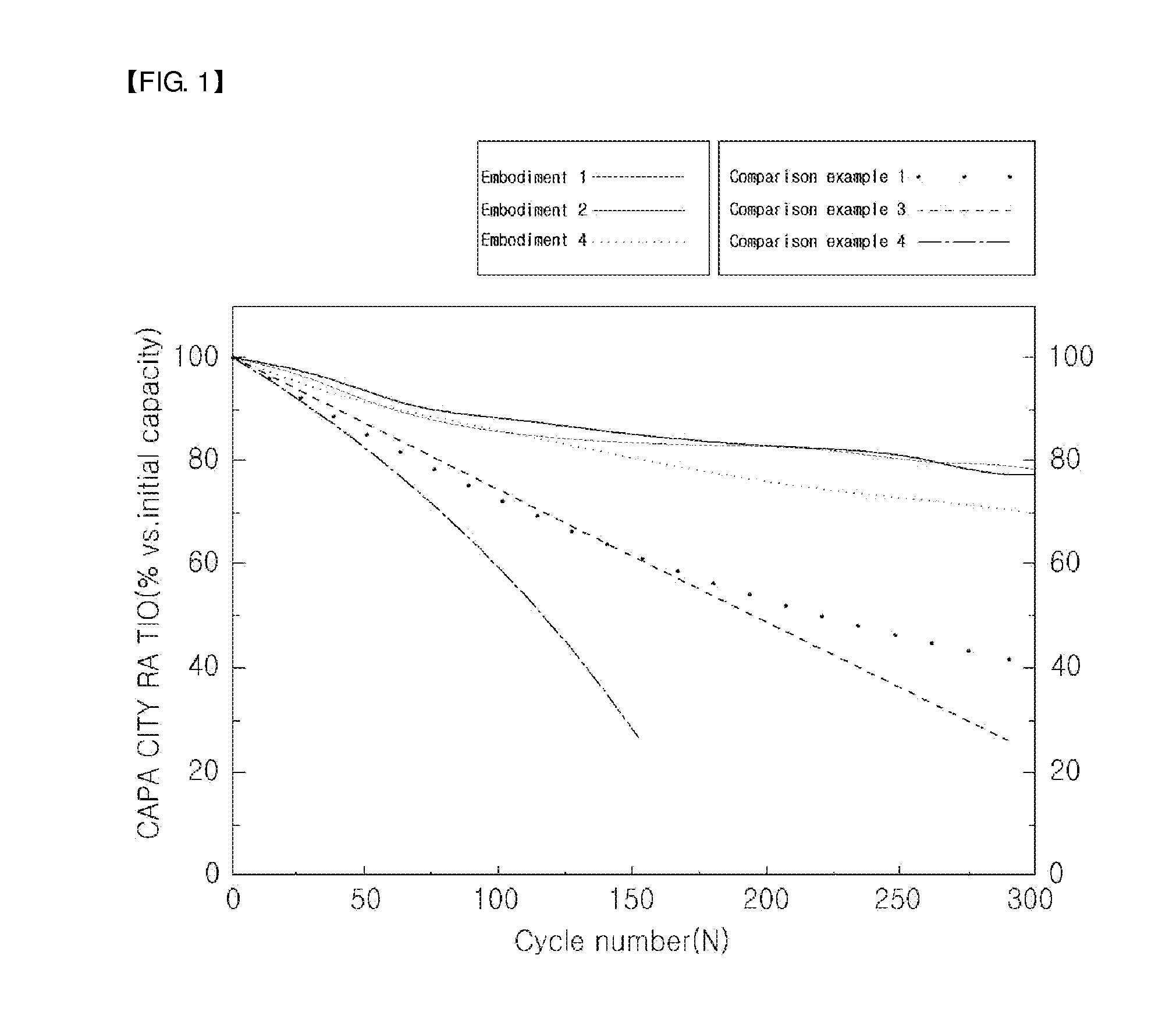Lithium secondary battery including water-dispersible binder, conduction agent, and fluoroethylenecarbonate
a secondary battery and water-dispersible binder technology, applied in the field of lithium secondary batteries, can solve the problems of reduced electrical conductivity of the electrode, unsatisfactory performance of the negative electrode using a water-dispersible binder, etc., and achieve the effect of improving the characteristics of the negative electrode, improving the lifespan of the high-efficiency charging and shortening the charging tim
- Summary
- Abstract
- Description
- Claims
- Application Information
AI Technical Summary
Benefits of technology
Problems solved by technology
Method used
Image
Examples
embodiment 1
Fabrication of Negative Electrode
[0056]Conductive carbon was put in a composition in which graphite and a binder were mixed, and the composition was dispersed in water, thereby fabricating a slurry (where graphite:binder (SBR):conductive carbon (Super-P)=98.6:1:0.4 wt %). The slurry was coated on copper foil, sufficiently dried at a temperature of 130° C., and then pressed, thereby fabricating the negative electrode. The negative electrode had a thickness of about 135 μm.
[0057](Fabrication of Positive Electrode)
[0058]A slurry was fabricated through dispersion in NMP (where LiCoO2:carbon black:PVdF=95:2.5:2.5 wt %). The slurry was coated on aluminum foil, sufficiently dried at a temperature of 130° C., and then pressed, thereby fabricating the positive electrode. The positive electrode had a thickness of about 140 μm.
[0059](Fabrication of Battery)
[0060]A polypropylene separation film was laminated between the positive electrode and the negative electrode and received in the battery c...
embodiment 2
Fabrication of Negative Electrode and Positive Electrode
[0061]The same as the embodiment 1.
[0062](Fabrication of Battery)
[0063]A polypropylene separation film was laminated between the positive electrode and the negative electrode and received in the battery casing. Next, an electrolyte (where ethylenecarbonate (EC):fluoroethylenecarbonate (FEC)=85:15 wt %) was injected into the battery casing and the battery casing was then sealed, thereby finally fabricating the battery.
embodiment 3
Fabrication of Negative Electrode
[0064]Conductive carbon was put in a composition in which graphite and a binder were mixed, and the composition was dispersed in water, thereby fabricating a slurry (where graphite:binder (SBR):conductive carbon (Super-P)=95.6:4:0.4 wt %). The slurry was coated on copper foil, sufficiently dried at a temperature of 130° C., and then pressed, thereby fabricating the negative electrode. The negative electrode had a thickness of about 135 μm.
[0065](Fabrication of Positive Electrode and Battery)
[0066]The same as the embodiment 1.
PUM
| Property | Measurement | Unit |
|---|---|---|
| particle diameter | aaaaa | aaaaa |
| thickness | aaaaa | aaaaa |
| thickness | aaaaa | aaaaa |
Abstract
Description
Claims
Application Information
 Login to View More
Login to View More - R&D
- Intellectual Property
- Life Sciences
- Materials
- Tech Scout
- Unparalleled Data Quality
- Higher Quality Content
- 60% Fewer Hallucinations
Browse by: Latest US Patents, China's latest patents, Technical Efficacy Thesaurus, Application Domain, Technology Topic, Popular Technical Reports.
© 2025 PatSnap. All rights reserved.Legal|Privacy policy|Modern Slavery Act Transparency Statement|Sitemap|About US| Contact US: help@patsnap.com


